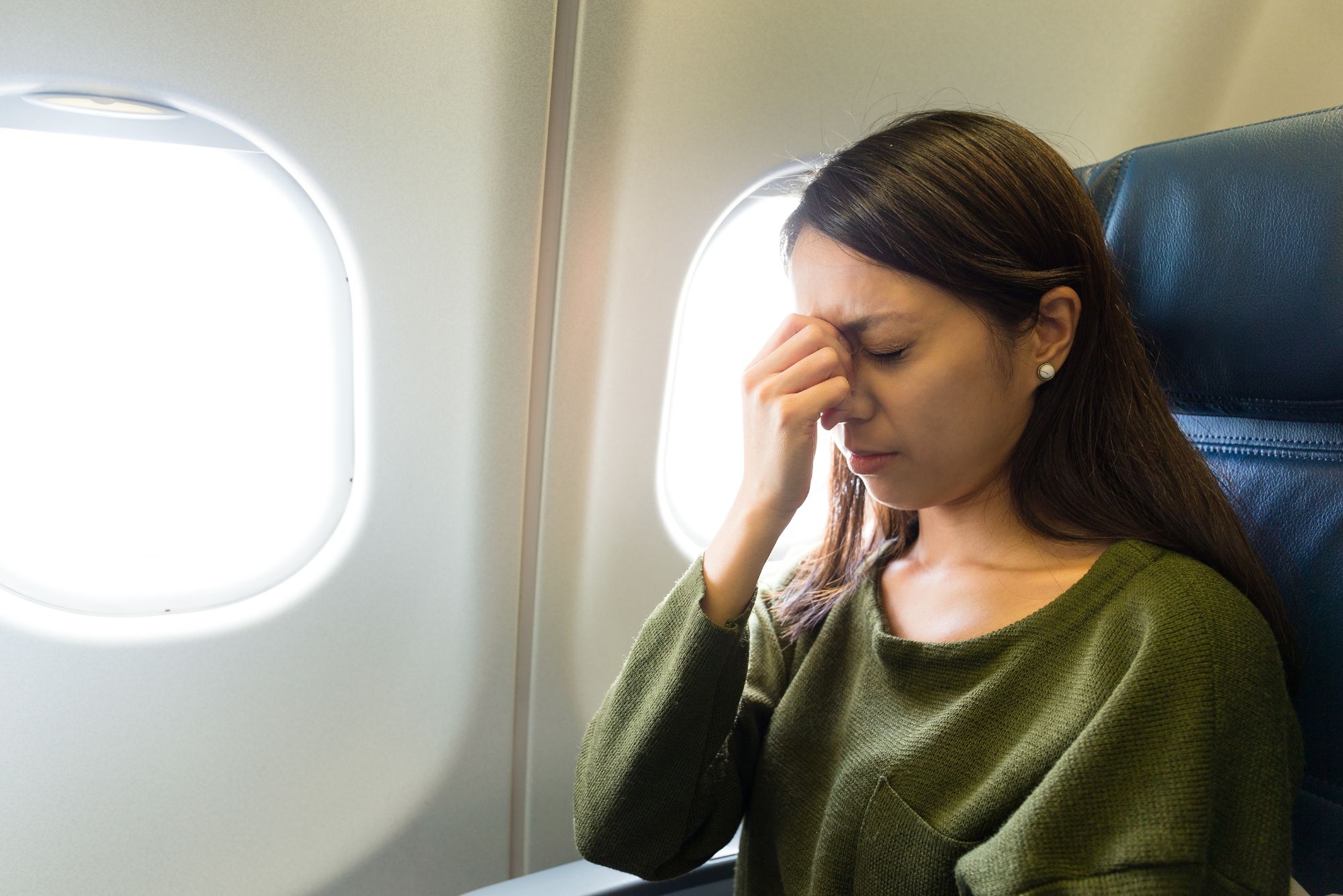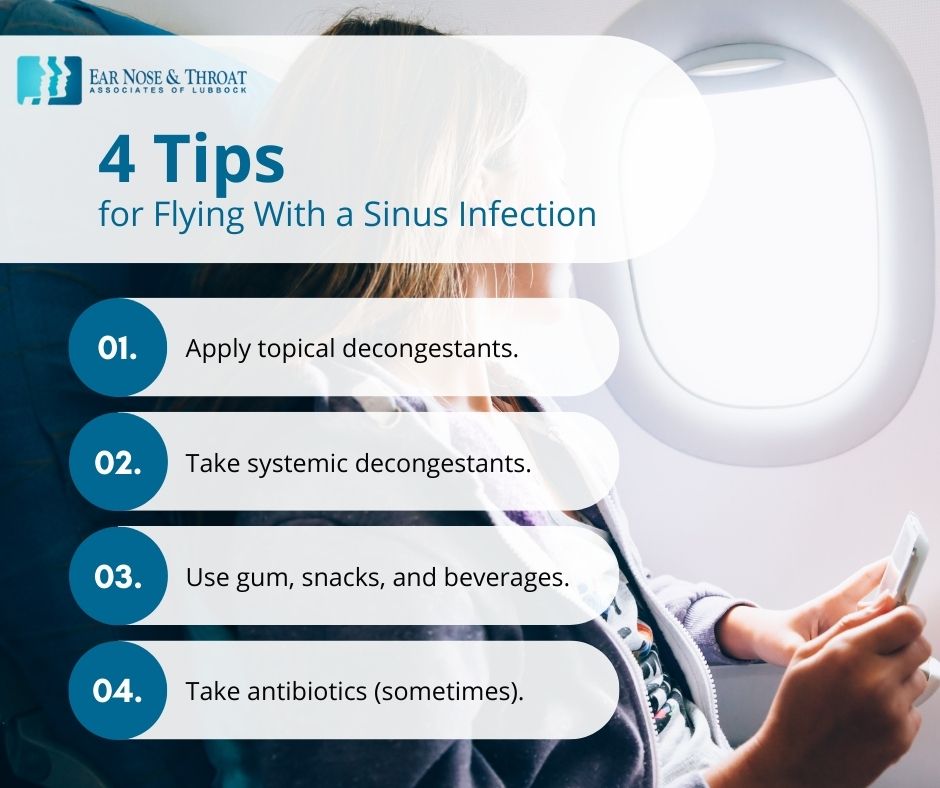A Doctor Gives 4 Tips for Flying With a Sinus Infection

If you’ve ever flown with a sinus infection, you’re probably not in a hurry to repeat the experience.
Flying with a sinus infection can be intensely painful, but what if you can’t avoid the trip? Can anything make the flight less torturous?
Let’s look at why sinus infections cause in-flight pain and four ways to make your air travel more comfortable.
Why Flying With a Sinus Infection Hurts
First, if you’re sick, and especially if you’re coughing, you probably shouldn’t be flying. Not only is it better for you to stay home and rest, it’s also better to keep from spreading your illness to others. That said, if you suffer from chronic sinusitis and/or severe allergies, you may end up needing to fly with a sinus infection or blocked sinuses.
The pain of flying with a sinus infection comes not from the infection directly, but from the changes in pressure during takeoff and landing.
The sinuses are air-filled cavities within your head, and they connect to the back of your nose through narrow drainage pathways. Normally, these pathways allow mucus and air to flow out of the sinuses and through the nose, but they can become blocked by severe congestion or a sinus infection. One of the consequences is that the air pressure inside your sinuses can no longer equalize with the air pressure around you.
The same principle applies if your ears become plugged due to your sinus infection. Your middle ear connects to the back of your nose via the eustachian tube, which can become blocked by congestion, preventing pressure equalization.
When you fly and the air pressure around you changes, the pressure within your blocked sinuses or ears stays the same, causing a great deal of pain. The four tips below focus on relieving this blockage to reduce the pain of flying with a sinus infection.

1. Topical Decongestants
Topical decongestants such as nasal steroid sprays can help relieve congestion almost immediately, and are available over the counter at any pharmacy. These fast-acting decongestants may reduce your congestion enough to open up your sinus passages and/or eustachian tubes, at least temporarily, and help you avoid a painful flight.
We recommend using a topical decongestant 30 minutes before your flight, allowing time for it to get to work before takeoff. One caution: Topical decongestants are a short-term solution, and using them for longer than three days can actually worsen your nasal congestion. So use them sparingly, and only when you need them for your flight.
Afrin (oxymetazoline) is one of the most common topical decongestants, but sometimes even a saline spray or rinse can help open up sinus passages without the risk of rebound congestion.
2. Systemic Decongestants
Systemic decongestants are another type of non-prescription drug designed to relieve nasal and sinus congestion. They come in pill form, rather than as topical sprays, and start working after your body absorbs them into your system.
Familiar brands like Sudafed, Allegra D, and Claritin D all contain pseudoephedrine, a systemic decongestant that reduces swelling and, consequently, may help open up your ears and sinuses.
However, systemic decongestants are not considered safe for people with high blood pressure or heart problems. If you fall into this category, you could try some home remedies for sinus infections instead.
3. Gum, Snacks, and Beverages
Chewing gum on a plane is a well-known way to help your ears “pop” as the pressure changes. That popping sensation is just your eustachian tubes opening up as you chew and swallow, allowing the pressure in your ears to equalize.
Keeping gum handy during takeoff and landing encourages chewing and swallowing, both of which can help your eustachian tubes open up, though it may not provide the same relief to your sinus passages. If you don’t like to chew gum, eating or drinking can provide a similar benefit by helping you swallow often. The more frequently you swallow, the more the pressure in your ears has a chance to equalize.
4. Antibiotics (Sometimes)
If you have a flight coming up and you have a sinus infection, it’s possible antibiotics could help clear the infection up faster. It’s important to note, though, that antibiotics will only help if your sinus infection is bacterial, not viral.
Most sinus infections are viral and resolve within 10 days with only over-the-counter medications and home remedies. However, if your sinus infection lingers longer than 10 days and you experience symptoms like facial pressure, headache, and fever, you may need an antibiotic.
Antibiotics are not a quick fix, so it’s best to start them well before your trip. They’re only available by prescription, so talk to your doctor as soon as you suspect you have a bacterial sinus infection.
Before Flying With a Sinus Infection
The symptoms of a sinus infections are very similar to the symptoms of other conditions, including colds, the flu, COVID-19, and even allergies. So while flying with a sinus infection is no fun, it’s important to be sure you’re actually dealing with a sinus infection.
Before you travel, we strongly recommend finding out what’s causing your symptoms to keep both you and those around you safe and healthy.
If you’ve had sinus infection symptoms for more than a week or 10 days, contact your doctor to determine the source of your condition and the best way to treat it. The sooner you have a clear diagnosis, the sooner you can take steps to feel better again.
Dr. Scolaro is a board-certified Otolaryngologist servicing the South Plains area. He has been practicing in Lubbock since 1990 and has earned a reputation as a skilled and experienced surgeon. He currently serves as the Medical Director for Covenant High Plains Surgery Center campuses, is a member of Covenant Health Partners and is an adjunct faculty professor for Texas Tech University Health Sciences Center School of Medicine. Learn more about Dr. Scolaro.
Categories:








